Advanced Studies Institute 2017 Program
The 2017 Advanced Studies Institute program consisted of the following four projects. Each project had one mentor and three students. Below are the project and team descriptions as well as a selection the guest lectures.
2017 Projects and Teams
Mentors: Nick Dallmann (P-21) & Bryce Tappan (M-7)
Students: Andrea Martinez, Nicholas Stull, Gregory Taylor
A very high thrust solid rocket system has been developed at LANL. There is interest in employing this technology in small satellites. However, the rocket would impart a large impulse over a very short timeframe to a vehicle with low moment of inertia. Even the slightest misalignment between the thrust vector and the vehicle center of mass will impart a torque and integrated angular momentum in excess of the satellite’s attitude control system capabilities. Traditionally, this type of problem would be solved with a combination of additional thrusters, active thrust vectoring, and/or additional vent paths. However, due to the very small size and very high level of impulse, these approaches are not likely adequate. High temperature valves, gimballing actuators, etc. are large and would likely add significant weight cutting into the mass fraction and effective performance of the system. The students working this project will need to become familiar with what has been done to solve this problem in the past and why those approaches are inadequate for this application. Then, the students will need to think outside the box to brainstorm and then analyze new solutions. See the link to an animation with LANL’s CubeSat and motor. http://www.lanl.gov/discover/news-release-archive/2016/October/10.13-rocket-motor-concept-could-boost-cubesat-missions.php
2017 ASI Student Bios
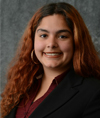 Andrea M. Martinez was born in Manhattan, NY. She received the B.S. and M.S degree in electrical engineering in 2014 and 2016 at the University at Buffalo, The State University of New York, where she is currently pursuing a Ph.D. in electrical engineering. She is a recipient of the National Science Foundation’s Graduate Research Fellowship. Her research interests include dielectric breakdown, dielectric elastomer actuators and partial discharges. Specifically, she is interested in the effects of electrode composition on partial discharge activity in dielectric elastomer actuators. She currently resides in Buffalo, NY.
Andrea M. Martinez was born in Manhattan, NY. She received the B.S. and M.S degree in electrical engineering in 2014 and 2016 at the University at Buffalo, The State University of New York, where she is currently pursuing a Ph.D. in electrical engineering. She is a recipient of the National Science Foundation’s Graduate Research Fellowship. Her research interests include dielectric breakdown, dielectric elastomer actuators and partial discharges. Specifically, she is interested in the effects of electrode composition on partial discharge activity in dielectric elastomer actuators. She currently resides in Buffalo, NY.
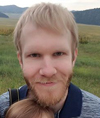 Nicholas D. (Nick) Stull earned a B.S. in Mathematics and a B.S. in Physics from Purdue University in West Lafayette, IN in 2008. He subsequently earned his Ph.D. in mathematics from Purdue University in West Lafayette, IN under the direction of Antonio Sa Barreto in 2015. He briefly served as an Assistant Professor in the Mathematics and Informatics Department at Trine University in Angola, IN, before coming to Los Alamos National Laboratory as a postdoctoral researcher under the direction of Eric Flynn in January of 2017. He currently conducts research on signature detection and signal/image processing. His current research focuses on 1) the development of data analysis techniques in conjunction with a laser-based scanning system developed for nondestructive evaluation on structures by Eric Flynn; 2) analysis of large time series data, specifically to detect and classify signatures in extremely noisy data.
Nicholas D. (Nick) Stull earned a B.S. in Mathematics and a B.S. in Physics from Purdue University in West Lafayette, IN in 2008. He subsequently earned his Ph.D. in mathematics from Purdue University in West Lafayette, IN under the direction of Antonio Sa Barreto in 2015. He briefly served as an Assistant Professor in the Mathematics and Informatics Department at Trine University in Angola, IN, before coming to Los Alamos National Laboratory as a postdoctoral researcher under the direction of Eric Flynn in January of 2017. He currently conducts research on signature detection and signal/image processing. His current research focuses on 1) the development of data analysis techniques in conjunction with a laser-based scanning system developed for nondestructive evaluation on structures by Eric Flynn; 2) analysis of large time series data, specifically to detect and classify signatures in extremely noisy data.
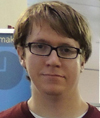 Gregory Taylor is a student studying Mechanical Engineering at New Mexico State University. Currently, his research involves characterization of bifurcation in the nonlinear vibrations in pipelines, and the use of carbon nanotubes for mass detection. He also has an interest in nonlinear control. Outside of university he enjoys playing strategy games, discussing politics, and eating good food.
Gregory Taylor is a student studying Mechanical Engineering at New Mexico State University. Currently, his research involves characterization of bifurcation in the nonlinear vibrations in pipelines, and the use of carbon nanotubes for mass detection. He also has an interest in nonlinear control. Outside of university he enjoys playing strategy games, discussing politics, and eating good food.
Mentors: Paul Dixon (SPO-CNP) & John Ahern (MET-1)
Students: Jacob Stinnett, Brendon Parsons, Elizabeth Phillips
There are 177 underground high-level waste storage tanks at Hanford. A significant number of these tanks are known to leak or be of unknown structural integrity. The current method of tank waste retrieval includes various permeations of using liquid to slurry waste and pump it to the treatment facility. This method utilizes large amounts of water and in known leaker tanks this presents risk of waste release to the environment. This makes the current water based waste removal systems difficult or impossible to use to remove the waste in many of tanks. A significant improvement to the waste removal process for these tanks could be realized if the waste was dry mined using small robotic based mining techniques. Development of a durable robotic mining capability is needed. In addition, if there was a way to stabilize the waste in the tank before it is mined out for instance using something like a 3D printing technique to make an intermediate waste form then fine particulate/dust control could be minimized making this mining technique safer. If this methodology were employed, it is likely that the mined waste could be placed in compliant shipping/disposal containers and directly disposed at an alternative disposal facility and not have to be made into glass logs. Using robotic mining and avoiding liquids in retrieving Hanford tank waste will lead a significant reduction in the potential for contaminated waste release to the environment and it will reduce exposure to the workers. The goal of this work is to explore and develop potential techniques to remove the waste from the Hanford Tanks in such a manner that it can be transported safety. Furthermore, we anticipate that part of this project may involve characterization of the waste to aid in the processing.
2017 ASI Student Bios
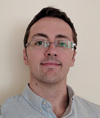 Jacob Stinnett is a Post-Doctoral Research Associate at Los Alamos National Laboratory. In December 2016, he earned his doctoral degree in Nuclear, Plasma, and Radiological Engineering from University of Illinois Urbana-Champaign where he developed nuclide identification algorithms for low-resolution handheld gamma-ray detectors. At LANL, his work ranges from algorithm development for gamma-ray spectroscopy to datamining text corpora. He is also teaches a variety of training courses, including the IAEA inspector school and the China Center of Excellence.
Jacob Stinnett is a Post-Doctoral Research Associate at Los Alamos National Laboratory. In December 2016, he earned his doctoral degree in Nuclear, Plasma, and Radiological Engineering from University of Illinois Urbana-Champaign where he developed nuclide identification algorithms for low-resolution handheld gamma-ray detectors. At LANL, his work ranges from algorithm development for gamma-ray spectroscopy to datamining text corpora. He is also teaches a variety of training courses, including the IAEA inspector school and the China Center of Excellence.
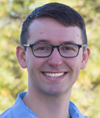 Brendon Parsons is a postdoctoral researcher in the Chemical Diagnostics and Engineering group at LANL working on gas headspace measurements and strategies for multivariate data processing. He graduated summa cum laude from the Harriet L. Wilkes Honors College in 2010 with a B.A. in liberal arts with a concentration in novel reaction strategies for synthetic organic chemistry. He received his Ph.D. in analytical chemistry in 2016 from the University of Washington, with contributions in multidimensional chromatography, algorithm development, and petroleum fuel forensics. His current research interests include gas chromatography, supercritical fluid extractions, radiolysis, and machine learning for sample classification and prediction. Likely attributable to his liberal arts background, he also enjoys reading about microeconomics, public policy, and scientific ethics. Beyond academic curricula, Brendon may be found around Los Alamos leading educational coffee tastings and demonstrations.
Brendon Parsons is a postdoctoral researcher in the Chemical Diagnostics and Engineering group at LANL working on gas headspace measurements and strategies for multivariate data processing. He graduated summa cum laude from the Harriet L. Wilkes Honors College in 2010 with a B.A. in liberal arts with a concentration in novel reaction strategies for synthetic organic chemistry. He received his Ph.D. in analytical chemistry in 2016 from the University of Washington, with contributions in multidimensional chromatography, algorithm development, and petroleum fuel forensics. His current research interests include gas chromatography, supercritical fluid extractions, radiolysis, and machine learning for sample classification and prediction. Likely attributable to his liberal arts background, he also enjoys reading about microeconomics, public policy, and scientific ethics. Beyond academic curricula, Brendon may be found around Los Alamos leading educational coffee tastings and demonstrations.
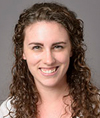 Elizabeth Phillips earned her B.S. in Chemical-Biological Engineering from MIT in 2013. Upon graduating, she worked first as a research specialist co-developing low-cost devices for the rapid detection of dengue, yellow fever, and Ebola viruses. She then joined the Pop Up Labs startup to direct the group’s international research collaborations and led the biological assay development of a modular health diagnostic prototyping kit. As part of her research, she spent four months in Chile and Nicaragua co-designing health and environmental monitoring tools. Now, as a National Science Foundation Graduate Research Fellow, she is pursuing a PhD in Biomedical Engineering at Purdue University where she is studying novel detection methods for bacterial infection diagnosis at patients’ point-of-care. Her research and teaching has brought her to 5 continents as she strives to empower patients with accessible healthcare technologies and improved scientific literacy.
Elizabeth Phillips earned her B.S. in Chemical-Biological Engineering from MIT in 2013. Upon graduating, she worked first as a research specialist co-developing low-cost devices for the rapid detection of dengue, yellow fever, and Ebola viruses. She then joined the Pop Up Labs startup to direct the group’s international research collaborations and led the biological assay development of a modular health diagnostic prototyping kit. As part of her research, she spent four months in Chile and Nicaragua co-designing health and environmental monitoring tools. Now, as a National Science Foundation Graduate Research Fellow, she is pursuing a PhD in Biomedical Engineering at Purdue University where she is studying novel detection methods for bacterial infection diagnosis at patients’ point-of-care. Her research and teaching has brought her to 5 continents as she strives to empower patients with accessible healthcare technologies and improved scientific literacy.
Mentors: Reinhard Friedel (Center for Space and Earth Science) & David Mascareñas (Engineering Institute)
Students: Tiffany Desjardins, Angelika Leskovskaya, Ryan McCombe
Understanding the seismic response of planets is often of interest. This information can be used to help determine the geophysical composition of a planet or moon. Similarly, asteroseismology focuses on developing techniques for inferring the internal structure of stars by considering how waves propagate inside the stars. By analyzing small variations in the light that is emitted by stars the natural frequencies of vibration can be measured. In the last few years there have been significant breakthroughs in image processing techniques for estimating the natural frequencies and full-field mode shapes of structures using only a video camera. The literature suggests these techniques have the potential to be very sensitive. The goal of this work is to explore the realm of the possible with respect to performing techniques such as elastic wavefield tomography of planets and moons using only imagers placed on a spacecraft. The team will explore what level of sensitivity could be achieved by such techniques, they will explore the possibility of novel imagers to make remote seismographic characterizations that have not been considered in the past, and they will propose a path forward on future engineering/science work that can enable the next generation of space-based seismology for inferring the internal structure of planets.
2017 ASI Student Bios
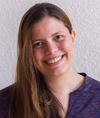 Tiffany Desjardins is Post Doc in P-24 at Los Alamos National Lab. She graduated with a Ph.D. in Electrical Engineering from the University of New Mexico, where she studied the basics of turbulence in a linear plasma device. Her current research is studying the hydrodynamic instability, the Richtmyer-Meshkov instability, in a high energy density regime using the OMEGA and NIF laser facilities.
Tiffany Desjardins is Post Doc in P-24 at Los Alamos National Lab. She graduated with a Ph.D. in Electrical Engineering from the University of New Mexico, where she studied the basics of turbulence in a linear plasma device. Her current research is studying the hydrodynamic instability, the Richtmyer-Meshkov instability, in a high energy density regime using the OMEGA and NIF laser facilities.
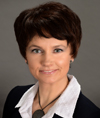 Angelika Leskovskaya is an Operations Research Ph.D. Candidate of Lyle School of Engineering’s Department of Engineering Management, Information, and Systems at Southern Methodist University in Dallas, Texas. She holds two master’s in Applied Mathematics and Economics from Belarussian State University. Her current research focuses on generalized interval-flow networks as a new extension of the classic generalized network formulation that adds a conditional lower bounds constraint on the arcs with the development and computational testing of interval-pivoting heuristics that exploit the quasi-tree-forest basis structure to explore extreme points. When not glued to a computer screen or teaching, Angelika likes running, skiing, swimming, trail running, reading (especially about computer science history), and spending time with her family and three boys.
Angelika Leskovskaya is an Operations Research Ph.D. Candidate of Lyle School of Engineering’s Department of Engineering Management, Information, and Systems at Southern Methodist University in Dallas, Texas. She holds two master’s in Applied Mathematics and Economics from Belarussian State University. Her current research focuses on generalized interval-flow networks as a new extension of the classic generalized network formulation that adds a conditional lower bounds constraint on the arcs with the development and computational testing of interval-pivoting heuristics that exploit the quasi-tree-forest basis structure to explore extreme points. When not glued to a computer screen or teaching, Angelika likes running, skiing, swimming, trail running, reading (especially about computer science history), and spending time with her family and three boys.
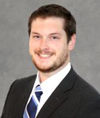 Ryan McCombe is working at Los Alamos National Laboratory as a post master’s student within Q-15. His current projects involve the study of material properties for energetic materials used in weapon systems and optical data acquisition and image processing techniques for explosives testing. His background includes a B.S. in Mechanical Engineering from University of Nevada, Las Vegas, and a M.S. in Mining and Earth Systems Engineering with emphasis in explosives applications from Colorado School of Mines. This coming August, He will be starting his PhD in Mechanical Engineering at New Mexico Tech, with a research focus in reactive materials characterization and fragmentation analysis. In his free time he enjoys camping, hiking, fishing, and exploring the southwestern United States.
Ryan McCombe is working at Los Alamos National Laboratory as a post master’s student within Q-15. His current projects involve the study of material properties for energetic materials used in weapon systems and optical data acquisition and image processing techniques for explosives testing. His background includes a B.S. in Mechanical Engineering from University of Nevada, Las Vegas, and a M.S. in Mining and Earth Systems Engineering with emphasis in explosives applications from Colorado School of Mines. This coming August, He will be starting his PhD in Mechanical Engineering at New Mexico Tech, with a research focus in reactive materials characterization and fragmentation analysis. In his free time he enjoys camping, hiking, fishing, and exploring the southwestern United States.
Mentors: Nandu Santhi (CCS-3) & Stephan Eidenbenz (Information Science & Technology Institute)
Students: Spencer Johnson, Rose Long, Benjamin Winter
Custom hardware architectures in the form of application specific integrated circuits (ASIC) can potentially accelerate physics applications several orders of magnitude. A common communication pattern in many of these architectures involves exchanging information with so called nearest neighbors of physical entities such as atoms. However, limited routing resources in current planar semiconductor technologies means that, we can physically interconnect to only a few neighbors at a time. Under such conditions, a way to achieve an all to all pattern is to let the communications be time multiplexed across available metal routes - which means that the overall architecture has a reduced performance per clock cycle. In essence, custom architectures have to either limit the number of neighbors to a small constant or, if all to all communication is a must, then severely limit the achievable hardware speedups. The objective of this project is to come up with novel solutions to this nearest neighbor communication problem, so that custom integrated circuits for typical physics problems such as the Ising problem, molecular dynamics and KMC may achieve the highest possible theoretical speedups in practice.
2017 ASI Student Bios
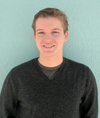 Spencer Johnson is a graduate research assistant here at Los Alamos, working on automated sensor ecosystems and blazar imaging with Thomas Vestrand in ISR-2. He completed his BSc at California State University, Los Angeles, and his master’s degree at the University of Cambridge, both in applied mathematics. He is currently preparing to begin PhD work in physics at the University of Illinois at Urbana Champaign. In his free time he enjoys all things nerdy, as well as some hiking when there’s not too much snow on the ground.
Spencer Johnson is a graduate research assistant here at Los Alamos, working on automated sensor ecosystems and blazar imaging with Thomas Vestrand in ISR-2. He completed his BSc at California State University, Los Angeles, and his master’s degree at the University of Cambridge, both in applied mathematics. He is currently preparing to begin PhD work in physics at the University of Illinois at Urbana Champaign. In his free time he enjoys all things nerdy, as well as some hiking when there’s not too much snow on the ground.
 Rose enjoys tinkering and building things; her goal is to find solutions to defined and undefined problems. After her tenure at the Engineering Institute at LANL, she became a PhD student in biomedical science at the Icahn School of Medicine at Mount Sinai (NYC). For her thesis, she studied the non-linear mechanics, biology, and biochemistry of the intervertebral disc; based on this research, she developed repair solutions for disc defects. After prototyping solutions, both inert and bioactive, she tested them in a variety of settings: loading whole discs in situ, monitoring cell behavior in vitro, and investigating performance in vivo (sheep). Besides her studies, she has built an unreleased mobile app that monitors and manages stress with biofeedback and mindfulness techniques. Rose also enjoys painting, running, cycling and climbing. She is currently looking for postdoctoral opportunities that leverage her expertise to create beautiful solutions to real problems. Her portfolio is at roselongphd [dot] com.
Rose enjoys tinkering and building things; her goal is to find solutions to defined and undefined problems. After her tenure at the Engineering Institute at LANL, she became a PhD student in biomedical science at the Icahn School of Medicine at Mount Sinai (NYC). For her thesis, she studied the non-linear mechanics, biology, and biochemistry of the intervertebral disc; based on this research, she developed repair solutions for disc defects. After prototyping solutions, both inert and bioactive, she tested them in a variety of settings: loading whole discs in situ, monitoring cell behavior in vitro, and investigating performance in vivo (sheep). Besides her studies, she has built an unreleased mobile app that monitors and manages stress with biofeedback and mindfulness techniques. Rose also enjoys painting, running, cycling and climbing. She is currently looking for postdoctoral opportunities that leverage her expertise to create beautiful solutions to real problems. Her portfolio is at roselongphd [dot] com.
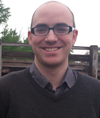 Benjamin Winter is a Ph.D. candidate finishing his degree in Civil Engineering at Michigan Technological University. Currently, his research involves structural control, wireless structural control, and health monitoring of seismically excited shear structures and bridges. His research interests lie in the application of smart materials for new forms of adaptive structural control. Time not devoted to research or teaching engineering students is spent going for walks with his family and cooking international cuisines.
Benjamin Winter is a Ph.D. candidate finishing his degree in Civil Engineering at Michigan Technological University. Currently, his research involves structural control, wireless structural control, and health monitoring of seismically excited shear structures and bridges. His research interests lie in the application of smart materials for new forms of adaptive structural control. Time not devoted to research or teaching engineering students is spent going for walks with his family and cooking international cuisines.
Signature Presentations
- Toni Taylor – An Introduction to the Science of Signatures
- Ed Fenimore – How to Mentor to Produce World-Class Scientists
- Nandu Santhi – Computational Architecture
- Yongchao Yang – Blindly Extracting Full-Field Structural Dynamics from Video
- Dave Clark – How to Write Proposals
- Kathleen McDonald – Tech Transfer
- Nick Dallmann – Cube Sat Properties
- Justin Anderson – Deter and Downsize: A Paradigm Shift for Nuclear Arms Control
- Michael Hargather – High Speed Refractive Imaging of Explosive Events
- Vince Kadlubek – Managing a Creative Community
- Jeremy Oepping – Team Effectiveness Workshop
- David Rogers – Scientific Data Visualization
- Alan Hurd – The Science Network & How to Promote Your Ideas
- Rafael Fierro – Control of Aerial Robotics
- Paul Dixon – Hanford Tanks Situation
- John Bowlan – Hyperspectral Images
- Katie Richardson – Government View of Research
- Jennifer Harris & Pulak Nath – Athena Project, Science & Engineering
- Michael Todd – How to Get Tenure at a University
- Eric Flynn- Laser Ultrasound
- Karl Jonietz – Collaborations
- John Ahern – Luminescence-Based Sensor for Rapid Detection of F-Elements
- Andrea Polli & Madeline Bolding – Design Thinking
- Brian Crone – Change of Station to Washington
- Tobias Fischer – Volcano Sensing and Prediction



